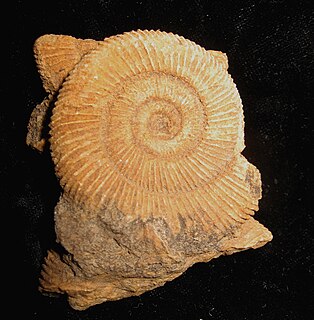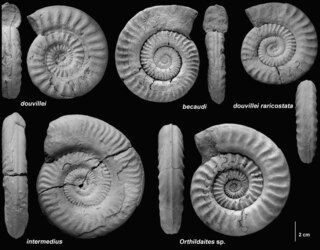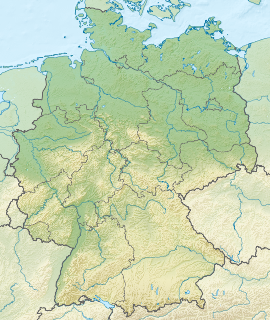
Dactylioceras was a widespread genus of ammonites from the Lower Jurassic period, approximately 180 million years ago (mya).
The Toarcian is, in the ICS' geologic timescale, an age and stage in the Early or Lower Jurassic. It spans the time between 182.7 Ma and 174.1 Ma. It follows the Pliensbachian and is followed by the Aalenian.

The family Dactylioceratidae comprises Early Jurassic ammonite genera with ribbed and commonly tuberculate shells that resembled later Middle Jurassic stephanoceratids and Upper Jurassic perisphinctids. Shells may be either evolute or involute.

Harpoceratinae is an extinct subfamily of cephalopods belonging to the family Hildoceratidae. Ammonites of this subfamily had involute and compressed shells with strong keels. Keel might be rarely missing, but this is considered to be an abnormality. This has been observed both in Cleviceras and Harpoceras and called as genus Monestieria, which is now known to be invalid. Another example is Pseudolioceras, whose unkeeled specimen was used as type for description of invalid genus Praehaploceras. Oxyconic forms of this subfamily does not have any keel. Ribs were single, but in some genera also bifurcating with shapes from sigmoidal to falcate. Sometimes, shell can have only striate ribs or is smooth. Tubercules are rare. Dimorphism is known in some genera and it is observable mostly in size. Macrochons can be 4, to 6 times larger than microconchs. As an example, macroconchs of Pseudolioceras are more than 150mm in diameter, while adult microconchs are only 35-50mm. There are big size differences even within dimorphs. Specimens ca be 2, or sometimes even 3 times bigger than other specimens of same dimorph.

The Marne de Flize is a geologic formation in France. It preserves fossils dating back to the Toarcian stage of the Jurassic period.
Porpoceras is genus of ammonite that lived during the early and middle Toarcian stage of early Jurassic. Members of this genus existed from uppermost part of the Harpoceras serpentinum zone to the Haugia variabilis zone. Their fossils were found in Europe, Asia, North America and South America.
Reynesoceras is genus of ammonites that lived during the upper Pliensbachian stage of early Jurassic. It has evolved from Prodactylioceras, or Cetonoceras. Dactylioceras (Eodactylites) has probably evolved from this genus. Aveyroniceras is a name for macroconchs of this genus. Their fossils were found in Europe, northern Africa, Asia, North America and South America.
Septimaniceras is genus of ammonites that has probably evolved from Peronoceras and lived during the middle Toarcian stage of early Jurassic. Members of this genus existed from Bifrons Subzone to lower part of Variabilis Subzone. Their fossils were found in France, Hungary and probably also in Austria.
Catacoeloceras is genus of ammonite that lived during middle to late Toarcian stage of early Jurassic. Members of this genus existed from Crassum Subzone of Bifrons Zone to Variabilis Zone. Their fossils were found in Europe, northern Africa, Asia, North America and South America. It has evolved from Peronoceras, or Porpoceras.
Nodicoeloceras is genus of ammonite that lived during early to middle Toarcian stage of early Jurassic. Members of this genus existed from Exaratum Subzone of Falciferum Zone to Commune subzone of Bifrons Zone. Their fossils were found in Europe, northern Africa, Asia, North America and South America. It has probably evolved from Dactylioceras (Orthodactylites) or Kedonoceras and gave rise to Mesodactylites.
The subfamily Nodicoeloceratinae comprises early Jurassic ammonite genera that lived during early to middle Toarcian stage. Origin of this subfamily is unknown, but first genus Nodicoeloceras has evolved from Dactylioceras (Orthodactylites) or Kedonoceras.
Mesodactylites, which is sometimes considered to be a synonym of Nodicoeloceras is genus of ammonite that lived during early to middle Toarcian stage of early Jurassic. Their fossils were found in southern and central Europe and northern Africa. It has evolved from Nodicoeloceras.
Transicoeloceras, which is sometimes considered to be a synonym of Catacoeloceras is genus of ammonite that lived during Toarcian stage of early Jurassic. Their fossils were found in Hungary, Italy, France, southern Spain and South America. It has evolved from Mesodactylites.
Telodactylites, which is sometimes considered to be a synonym of Porpoceras is genus of ammonite that lived during Toarcian stage of early Jurassic. Their fossils were found in Europe, northern Africa and South America. It has probably evolved from Mesodactylites.

The subfamily Dactylioceratinae comprises early Jurassic ammonite genera that lived during Upper Pliensbachian to Upper Toarcian stage. These dactylioceratids existed from Margaritatus ammonite Zone, when they have evolved from Reynesocoeloceratinae and died out in Variabilis Zone without leaving any descendants.
Mucrodactylites, which is sometimes considered to be a synonym of Collina, is genus of ammonite that lived during middle to late Toarcian stage of early Jurassic. Their fossils were found in Europe, northern Africa and South America. Species belonging to this genus were probably microconchs of Catacoeloceras. As macroconch of M. mucronatus is considered to be Catacoeloceras raquinianum.

Orthildaites is a genus of ammonites that lived during the lower Toarcian stage of early Jurassic, during Falciferum subzone.

Juraphyllites is a genus of ammonites belonging to the family Juraphyllitidae.

Mercaticeras is an extinct genus of ammonites belonging to the family Hildoceratidae.

The Dactyliocerassandstein Formation is a Lower Jurassic geologic formation primarily located in Bavaria, Germany. The Formation appears on places like Bruck in der Oberpfalz, the north-east of the Banz Abbey, Wittelshofen, Regensburg and Bodenwöhr. In the astly foreland it extends from the Kulmbach area via Bayreuth, Creussen, Hirschau and Amberg to Schwandorf. Its southernmost known occurrences seems to be Schwandorf himself and Haselbach, altrougth is also found at Bachhausen, far at the south. Is composed mostly by clusters of clay sandstone and sand-lime stone facies occurs only in the south-east of the northern Bavarian Jura region, for example at the edge of the granite Bavarian forest. On its northern edge, it is noticeably less tectonically disturbed in the Bodenwoehr basin near Sollbach. On the western edge it only appears on the Keilberg and Irlbach . It is a deposit recovered It is the same age as the marine Posidonia Shale, and has been identified as part of it in many sources. The formal relationship between the two layers, however, is undefined; the Posidonia Shale is sometimes described as a different coeval unit or a changed sector, possibly with more terrestrial influence. The extent of the major outcrop of the formation is not clearly delimited. It has been observed in Straßkirchen, Bogen, Straubing; its westernmost points are in Pfatter and a deep outcrop in Keilberg. The name of the Formation derives from the presence of Dactylioceras commune and annulatum, as part of the Monotis-Dactylioceras Bed present along the Lower Toarcian deposits on Bavaria. This Dactylioceras bank was recognized as the facies of the peel-poor bank, and wasn´t destroyed in the Bifrons regression, hence the acummulation of Ammonites and the name of the layer. Is even preserved in the coastal area of the sand deposit, when the regression probably increased the transportability of the water so large that the thin, light Pseudomonotis (=Arctotis) shells were moved, but not the heavy ones, which at that time already contained sands filled of Dactylioceras specimens.









